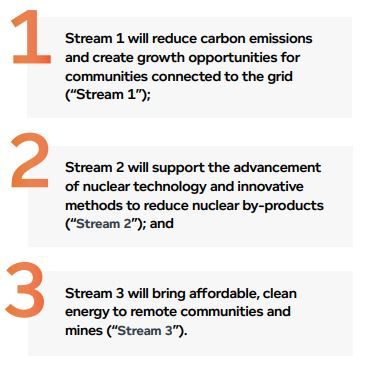In 2020, efforts continued to carve out a place in Canada's energy sector for small modular reactors ("SMRs"). SMRs are an emissions-free, reliable and readily deployable distributed generation baseload technology that is lauded as a key piece of the puzzle to help achieve federal, provincial and territorial decarbonization targets, as well as address numerous energy challenges arising from Canada's geography, load requirements and international commitments. These efforts include the federal government's launch of the Small Modular Reactor Action Plan (the "Action Plan") in December 2020, as well as steps taken by certain provincial governments and industry players to promote and advance SMR technology in Canada. With a potential export market of $150 billion per year, the federal government is tantalized by the great economic opportunity that SMRs present. Unsurprisingly, Canada is not alone in its efforts to develop SMRs; the global race to bring the first commercially viable SMR technology to market is highly competitive. Key players, such as the US, the UK, Russia and China, have committed substantial government funding and made significant advancements in SMR technology to date.
The Action Plan
On December 18, 2020, Canada's Minister of Natural Resources, Seamus O'Reagan, released the Action Plan to build on Natural Resources Canada's 2018 publication 'A Call to Action: A Canadian Roadmap for Small Modular Reactors' (the "Roadmap"). The Action Plan responds to the Roadmap's recommendations with a statement of seven principles. These principles will guide Canada in the development, demonstration and deployment of SMRs to benefit Canadians economically, environmentally, geopolitically and socially. 109 organizations from across Canada participated in the Action Plan, including the federal government, provinces and territories, Indigenous Peoples and communities, power utilities, industry, innovators, laboratories, academia and civil society. All of the participants endorsed the Action Plan's statement of principles and contributed a chapter to the Action Plan. These chapters detail the actions that participants are taking, or plan to take, to further Canada's goal of being a global leader in SMR technology.
The Action Plan endorses nuclear energy, and SMRs in particular, as being key to helping Canada and the rest of the world achieve a low-carbon future. Canada has committed to reducing its greenhouse gas emissions under the Paris Agreement and to retiring all coal-fired power generation by 2030. An even loftier goal was set out with the tabling of Bill C-12, the Canadian Net-Zero Emissions Accountability Act, in November 2020 ("Bill C-12"). Bill C-12 aims to legislate Canada's pledge of achieving net-zero greenhouse gas emissions by 2050. In order to achieve these targets, Canada's energy mix must shift away from carbon-emitting energy sources.
The integration of renewable energy sources with SMR technology could be part of the solution to achieving these emissions targets. As renewable energy sources such as wind and solar are not available on demand, another source of energy is required to ensure reliable power. Zero-emissions load-following resources ("ZELFRs") can fill the gaps in variable renewable energy supply by adjusting their output based on fluctuations in demand, providing a continuous, reliable and non-emitting source of energy. Innovations in Generation IV reactor technology are predicted to allow SMRs to be an extremely promising ZELFR, considering its potential commercial viability and rapid load-following capability. Generation IV reactors are the primary focus of SMR development and six Generation IV reactor technologies are currently being researched by the Generation IV International Forum (the "GIF"). The six technologies that the GIF is researching were selected on the basis of their potential as clear, safe and cost-effective means to sustainably increase energy supply, while being resistant to materials diversion for weapons proliferation and being secure from terrorist attacks. The GIF is a co-operative international endeavor, in which Canada is a participant, that seeks to research and test the feasibility of Generation IV technology.
Canadian Technology and Funding Updates
A necessary first step in SMR development, buy-in from Canadian political leadership, gained additional critical mass in August 2020 when Alberta Premier Jason Kenney announced that Alberta would sign the inter-provincial memorandum of understanding (the "SMR MOU") to advance the development and deployment of SMRs, along with addressing climate change, regional energy demand, economic development and research and innovation technologies. Alberta will be the fourth province to join the SMR MOU, which was entered into by Saskatchewan, New Brunswick and Ontario on December 1, 2019.
As a result of the SMR MOU, the CEOs of the major electricity utilities in Ontario, New Brunswick and Saskatchewan, including Bruce Power, Ontario Power Generation ("OPG"), New Brunswick Power ("NB Power") and SaskPower (collectively, the "CEO SMR Forum"), are collaborating to achieve industry alignment on the development and deployment of SMRs in Canada. The CEO SMR Forum has been developing three streams of SMR projects to be developed in parallel with equal priority:

In furtherance of Stream 1, Bruce Power, SaskPower and OPG are collaborating to determine the feasibility of gridscale connected SMR technology and to determine the optimal technology option for Canada. OPG proposes to build a first-of-a-kind grid-scale SMR of approximately 300-400 MW at its Darlington Nuclear Power Station, with a targeted start up date in 2028. Following the successful deployment of the SMR technology at Darlington, SaskPower is evaluating the economic and technical feasibility of deploying 300 MW of generating capacity from SMRs by 2032, with the potential for a further 900 MW between 2035 and 2042. On October 6, 2020, OPG announced that it is advancing engineering and design work on the project with three developers:
GE Hitachi Nuclear Energy, a US based US-Japanese collaboration, Terrestrial Energy, an Ontario developer, and X-Energy, a US developer. The Canadian Nuclear Safety Commission's ("CNSC") vendor design review ("VDR") of Terrestrial Energy's Integral Molten Salt Reactor ("IMSR") began in 2016 and is expected to be completed in 2021. GE Hitachi Nuclear Energy submitted two packages to the CNSC for the VDR of its BWRX-300 SMR in January 2020, and X-Energy submitted its scalable 80MWe Xe-100 SMR to the CNSC for VDR in July 2020.
New Brunswick has taken the lead on Stream 2. In November 2020, NB Power, Moltex Energy, a UK company ("Moltex") and Advanced Reactor Concepts (the parent company of ARC Nuclear Canada Inc., "ARC Canada") announced that they signed a memorandum of understanding to establish a SMR vendor cluster in New Brunswick and to advance Generation IV grid sized SMR technology. This memorandum of understanding follows the New Brunswick government's $10 million investment in ARC Canada and Moltex in 2018 to assist in the development of their advanced Generation IV SMR designs. ARC Canada's ARC-100 design, a sodium.cooled fast reactor, and Moltex's SSR-W design, a Stable Salt Reactor - Wasteburner, are expected to be demonstrated at the Point Lepreau Nuclear Generation Station in the early to mid 2030s. It is worth noting that Moltex has also received financial support from the UK and US governments.
Stream 3 projects involve micro SMRs that can be used to displace diesel generation currently used in remote areas for mining and in northern remote communities for heat and electricity generation. On June 9, 2020, OPG announced its partnership with Ultra Safe Nuclear Corporation, a Seattle-based technology company, on a joint venture called Global First Power. The project proposes to build a first-of-a-kind 15 MW thermal micro modular reactor at Chalk River Laboratories. The project is Canada's first SMR with an active Environmental Assessment and CNSC license application. The project has announced it is on track to deliver Canada's first SMR installation in early 2024. In October 2020, Bruce Power announced its collaboration with Westinghouse Electric Company ("Westinghouse") to determine the feasibility of Westinghouse's eVinci micro reactor in Canada and potential applications and frameworks for deployment. Westinghouse submitted the eVinci micro reactor to the CNSC for VDR in 2018.
The Global Race to Achieve Commercially Viable SMR Technology
Canada was not alone in making efforts in 2020 to further the development of commercially viable SMR technology. Many countries, including the US, UK, Russia, China and Argentina, made technological advances and increased their funding of SMR projects in the hopes of being the first to market in order to set the global standard in SMR technology.
On October 16, 2020, the US Department of Energy ("DOE") awarded USD $1.355 billion to the Utah Associated Municipal Power Systems ("UAMPS") owned Carbon Free Power Project, formally launched in 2015 in partnership with Portland based NuScale Power. The investment is intended to further the development of a potential 720 MW SMR plant to be located in Idaho. This DOE award follows the $16.6 million cost-shared funding provided by the DOE to UAMPS and NuScale Power in 2015. Construction of the plant is scheduled to begin in 2025, with the first module expected to be operational in 2029. NuScale Power achieved a significant milestone in August 2020 by receiving the first SMR approval issued by the Nuclear Regulatory Commission.
UK Prime Minister Boris Johnson announced in November 2020 that the UK government would be investing up to £215 million in SMR development through the UK SMR consortium, to be delivered as part of UK Research and Innovation ("UKRI"). This investment follows the £18 million invested by UKRI in the consortium in November 2019. The consortium's program is scheduled to enter its next phase of development in May 2021, which aims to raise an additional £300 million to deliver a fully-engineered and fully approved product.
Russia, China and Argentina appear to have the most advanced technologies. Russia's Akademik Lomonosov is the world's first floating nuclear plant and the first nuclear power plant based on SMR technology to generate electricity. The plant has been connected to the grid and began commercial operation in May 2020. The plant was developed by Rosatom, a Russian state nuclear energy corporation, and is hoped to be a breakthrough for providing sustainable power to the Arctic and other remote, hard-to-reach areas all over the world. Russia is also developing a land-based SMR project that is scheduled to be operational in 2027. One of China's SMR designs is HTR-PM, an industrial demonstration in the advanced stages of construction. The SMR is scheduled to begin power generation later this year. Argentina's CAREM SMR prototype is also in advanced stage construction, with operations scheduled to begin in 2023.
The Future of SMRs in Canada
SMR technology holds the potential to help Canada achieve its net-zero emissions target by 2050. The potential of SMR technology has been recognized globally, as 72 reactors are in development in 18 countries, with efforts taken during 2020 to advance the commercial viability of SMR projects globally. Canada is well-positioned to be a global leader in this industry, using its almost 80 years of nuclear energy expertise to guide the development of its SMR projects. However, the competition is intense from both international SMR technologies and alternative existing and developing low-emission energy generation technologies. Canadian champions will need sustained government support of SMR projects, patient venture capital and public acceptance to displace other forms of new or incumbent domestic energy production and to provide a domestically produced SMR solution in Canada that can compete on the world stage.
To view the original article click here
The content of this article is intended to provide a general guide to the subject matter. Specialist advice should be sought about your specific circumstances.





